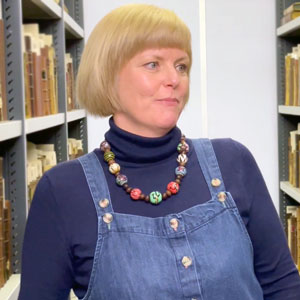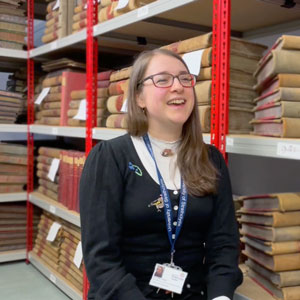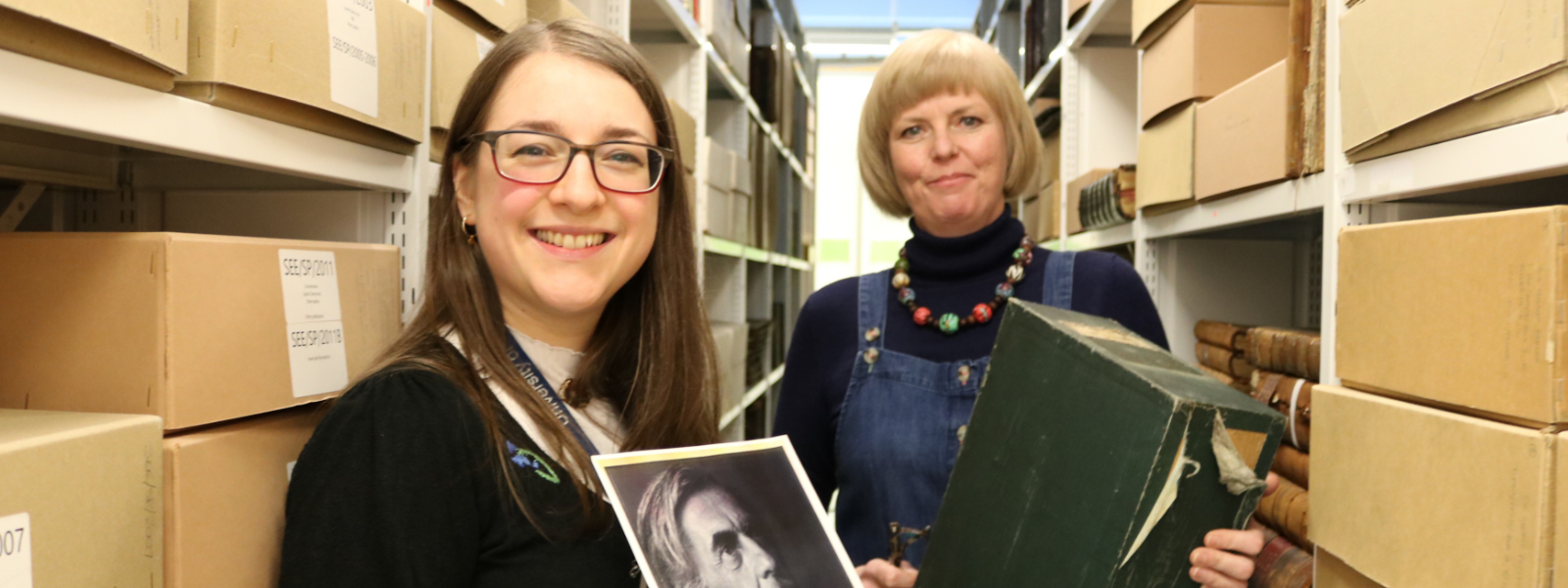Catch up with Eleanor

We had a few more questions for Eleanor, read on to find out more.
Who was Archie Hind?
Archie Hind was born in 1928 and is best known for his novel The Dear Green Place (1966). It was his only published novel in his lifetime. It’s a novel about writing a novel, and in many senses one about a novelist who fails to write his own novel. It’s also a novel with a deep connection to the city of Glasgow.
When The Dear Green Place was published in 1966, it was to great acclaim. It won the Guardian Fiction Prize and Yorkshire Post Prize that year and it really put Hind on the map. There was a lot of publicity surrounding it and he became quite famous for a while – something that was short-lived. But it had huge reverberations at the time and was recognised as an important novel in Scotland in wider British culture.
Hind didn’t go on to complete another novel after that, but he also had a large body of other work including literary writings, journalism, plays and correspondence.
Tell us about your history with Hind and his work.
The Dear Green Place is a novel that I’ve been teaching for many years to students on my course on ‘The Glasgow Novel’. I’m currently working on a book on Scottish literary magazines and Archie’s name pops up a lot in these (he was writing for magazines such as Scottish International in the late Sixties). He was also involved in a variety of other projects, such as The Easterhouse Project, where he was working to reduce knife and gang violence.
While I’ve had an interest in Hind’s work for a long time, I had very little context on his life and work. As far as I could tell, there were no papers relating to him and I certainly didn't think any of his manuscripts still existed.
Whenever I’d asked colleagues or people at conferences or people who may have known Archie in the past whatever had happened to his materials, no one really knew.
How did you discover the manuscript was still in existence?
I had given up hope of ever finding anything relating to his work until a chance chat with a friend who put me in touch with Archie's daughter, Sheila.
Sheila was in the process of moving back to the south of France and just happened to have a crate of materials in the back of her car that she wanted to find a home for. She wasn’t really sure where the papers should go. We had a few telephone conversations, then arranged to meet. I’ll never forget the day she arrived at my house with all the materials, including a dusty old box, with creaky hinges, which contained the manuscript of The Dear Green Place. Coming across the original manuscript of a novel I admired so much really was a goosebump moment. Seeing it sitting on my kitchen table was quite surreal!
How does it feel to have this collection at Strathclyde?
The Dear Green Place is a novel about the working-class artist trying to write his own ‘magnum opus’, something our own students in English & Creative Writing can often relate to. Throughout the novel is a deep concern with whether the artist can flourish in Glasgow (taken from the motto in the Coat of Arms, ‘Let Glasgow Flourish!’). This symbolism of the Coat of Arms recurs throughout the novel (‘the bell that never rang, the fish that never swam, the bird that never flew and the tree that never grew’). These images of stasis recur throughout, in stark contrast to the need to create. It’s a novel about these kinds of artistic struggles, but it’s also a novel that demonstrates a deep love for Glasgow. Glasgow is seen in all its true colours. It's a post-industrial wasteland, a place of ugliness, but also a place of beauty. And the novel explores the tensions between these extremes.
At Strathclyde we’ve always had strong links with Scottish literature, and the fact that we now have Archie Hind’s archive in the library is fantastic for our students as well as the wider literary community.
Apart from The Dear Green Place, what else is in the collection?
It’s quite a treasure trove. We have the manuscript for Hind’s incomplete novel, Fur Sadie, which just abruptly stops and there’s a bit of a puzzle as to whether the final sections of the novel still exist.
We have lots of correspondence with important Scottish writers. Hind had a 50-year friendship with Alasdair Gray and there's lots of deep connections with Alasdair’s work throughout the archive. We have correspondence with writers such as Ian Hamilton Finlay and Joan Ure. We also have correspondence with Willa Muir, who was married to Edwin Muir. Archie had studied at Newbattle Abbey College in Midlothian under Edwin Muir in the 1950s.
We also have lots of materials relating to Archie's plays - for example, The Ragged Trousered Philanthropists which was produced by 7:84 Theatre Company.
It's just the early days of our project, so we really need to scope this out in more detail and to ascertain the depth of the interconnections between all the materials that we have.
How has it been working with Archives & Special Collections?
It's been fantastic to work collaboratively with Archives & Special Collections. We've formed a nice little team and work very closely together on the process of how we're going to look after this archive.
In particular, it’s been great to work with Rachael Jones, Assistant Archivist, who has been teaching me about things such as box listing. I'm learning about how archivists do things, the importance of the preservation of materials and copyright, and so on. Rachael has even given me a tutorial on the correct way to remove a rusty paperclip without damaging the original paperwork!
We are just at the early stages of working out how we will begin to catalogue all this, with a view to digitization in the future as well. That’s all in the pipeline, especially leading up to Archie’s centenary which will be in 2028 and the 60th anniversary of The Dear Green Place in 2026.
Catch up with Rachael

Rachael Jones on what this discovery means for Strathclyde Library:
How does it feel to have acquired this collection for Archives & Special Collections?
The collection of papers of Archie Hind is a really significant one for Strathclyde. It's such a good fit for the institution - a good fit geographically and such a boon to have this high quality collection of papers relating to a Scottish literary figure. It also directly supports research that's going on right now at the university.
The family of Archie Hind were keen to find a safe home for these papers and they'd written to a couple of other archives around Glasgow. But as soon as Eleanor came to us with the information about this collection and how significant these papers were to her study of Scottish literature, we knew that it was a collection that was definitely worth having.
With this being a seminal Glasgow novel and the university being at the heart of the city, it makes sense to have the papers here. More than that, we’ve got other collections within our Special Collections to do with Glasgow novels and the history of the city and correspondence from Glasgow writers, with whom Hind had a connection, can be found in some of our other archives collections. So this was a great fit for the rest of our collections.
Tell us about the process once a collection like this is desposited.
When the collection first came in, we met with the family to formally accession the collection and to sign a gift agreement which brought the collection under our jurisdiction.
The first stage to gaining intellectual control over a new collection is creating an inventory. We would normally do this ourselves but we were delighted that Eleanor agreed to do it for us. Her expertise proved invaluable in recognising what everything was.
After a collection is box listed you can then begin a more formal cataloguing process whereby you try to create a meaningful arrangement. The purpose here is to try to recreate the order that Hind himself may have kept his papers in, rather than impose your own subjective and potentially misleading arrangement.
At that point, you add in a lot more contextual information so that researchers know what is in the collection, who created it, when, and for what purpose. To have Eleanor's subject specialist knowledge is so useful to really understand what each of these documents and items are, what their significance is, and what other links they have.
What’s next? When will the collection open to researchers?
Before the collection is open to researchers, we're going to work together with Eleanor to fully catalogue and do preliminary research on the collection. Then we can explore digitisation of the collection, and adding further detailed descriptions, before opening up the collection to all researchers.
The collection found its way to the University of Strathclyde at just the right time. In just two years it will be the 60th anniversary of the publication of the novel The Dear Green Place and in 2028 it will be the centenary of the birth of Archie Hind. So what better date to celebrate this collection?
Learn more
Read more about the process of archiving and preserving Archie Hind's work at the StrathArchives blog.



